Hair extensions have become increasingly popular among clients seeking to enhance their hairstyles. For salon owners, understanding the various types of extensions is not just beneficial but necessary for meeting customer demands. This post will delve into the essential types of hair extensions every salon owner should be familiar with, including ponytail extensions, tape-ins, and wefts.
Ponytail Extensions: The Instant Style Upgrade
Ponytail extensions are designed to quickly transform any look with minimal effort. They come in various styles and lengths, allowing clients to choose a ponytail that best suits their preferences. These extensions are typically made of high-quality human hair or synthetic materials resembling natural hair. For customers seeking an elegant and sophisticated appearance, ponytail extensions present the perfect solution. Owners should stock a range of textures and colors, including options like the Honey Blonde Remy Hair Ponytail, to cater to their clientele. By offering this versatile styling option, salons can appeal to those who desire an instant glam upgrade without the commitment of traditional extensions. One of the significant advantages of ponytail extensions is their ease of application. Clients can often put them on themselves within minutes and achieve a chic look for any occasion. This trend is especially popular among busy individuals who frequently attend parties or events.
Tape-In Extensions: Half the Time, Double the Volume
Tape-in extensions have gained immense popularity among those looking for semi-permanent solutions to add length and volume. Bonded with double-sided tape, these extensions can be applied quickly and typically last for about eight weeks. This technique is favored for its low-maintenance nature, making it convenient for clients who may lack the time for frequent salon visits. One crucial aspect for salon owners to note is the variety of options available when it comes to tape-in extensions. Different textures, lengths, and colors are essential in ensuring that every client finds the perfect match for their natural hair. Moreover, it’s vital to offer extensions made from high-quality human hair rather than synthetic alternatives to ensure a natural-looking finish.
Weft Extensions: A Customizable Choice
Weft extensions are an extremely versatile option. They come in two forms: machine-sewn and hand-tied. Both types can be applied using various methods, such as adhesive bonds or microbeads, providing salon owners with flexibility in application techniques. This option is appealing to clients who want a more tailored fit for their extensions, based on their hair texture and volume. One of the benefits of weft extensions is their longevity. When properly installed and cared for, salon clients can enjoy their extensions for several months. However, they do require more maintenance than other types, leading salon owners to emphasize aftercare guidance for their clients.
Clip-In Extensions: Convenience at Its Best
Clip-in extensions are perfect for clients seeking versatility and instant results without commitment. They can be easily applied and removed, allowing users to toggle between their natural look and longer locks in a matter of minutes. These extensions are particularly suited for clients who want to try out different styles without investing in semi-permanent options. As a salon owner, it’s important to explain the benefits and limitations of clip-in extensions to clients. Although they provide a quick way to add length and volume, proper handling and care are critical to avoid damage to the natural hair. Clients should be informed about which practices can extend the lifespan of their clip-in extensions.
Fusion Extensions: The Traditional Powerhouse
Fusion extensions remain one of the most sought-after options for those looking for a more permanent solution. This method involves fusing individual strands of hair to the natural hair using a keratin bond. The result is an extremely natural look that blends seamlessly with the client’s existing hair. While fusion extensions can last longer than many other methods, the installation process can be time-consuming and requires skilled stylists. Salon owners should ensure that their staff are well-trained to provide these services, as improper application can lead to damage and dissatisfaction. Furthermore, educating clients about regular maintenance is vital to keeping fusion extensions looking their best. Recommended maintenance appointments should be scheduled approximately every three months to replace any weak bonds and ensure ongoing satisfaction.
Micro-Link Extensions: A Gentle Approach
Micro-link extensions, also known as micro-bead or i-tip extensions, have gained traction as an alternative to traditional bonding methods. They use small metal rings or beads to attach the extensions to the natural hair, allowing for a strain-free experience. This method is particularly appealing for clients concerned about heat and chemical damage. The application and removal process of micro-link extensions is less invasive compared to fusion methods.
With knowledge at your fingertips, you can cater to each client’s individual needs, ensuring they leave your salon satisfied with their beautiful new look. A diverse selection of hair extensions can set your salon apart, allowing clients to choose the perfect option for their lifestyle and hair goals. By providing education, high-quality products, and professional services, salon owners can build lasting relationships with their clientele.








































